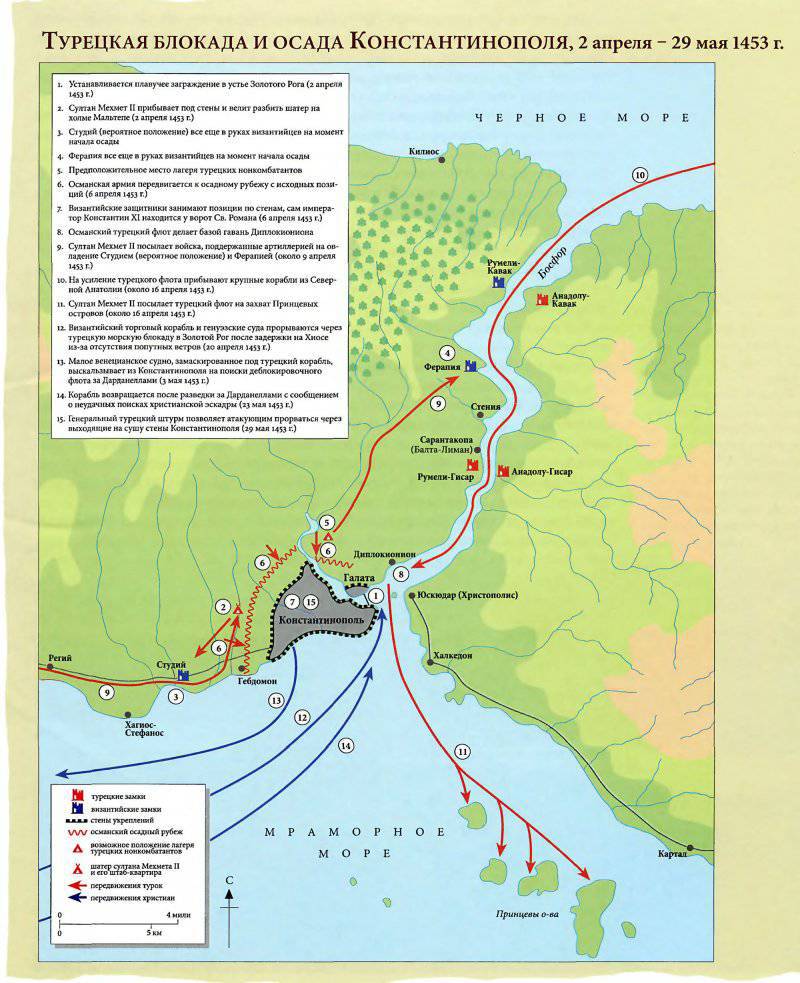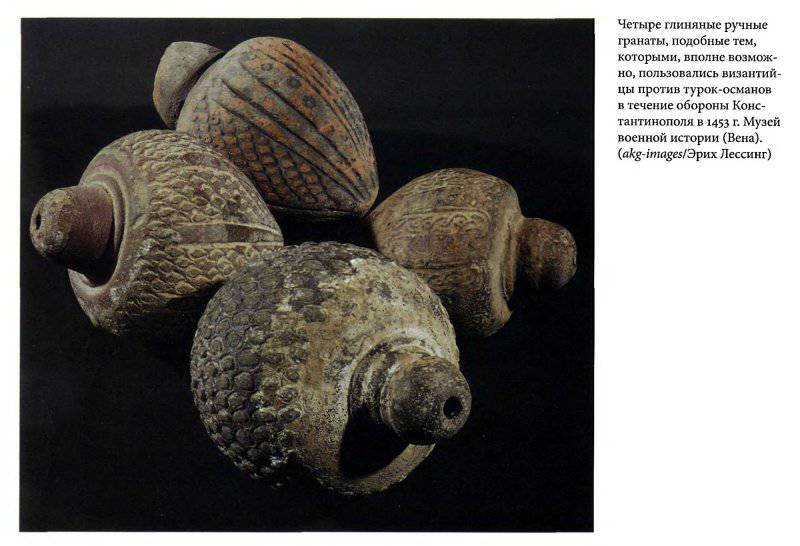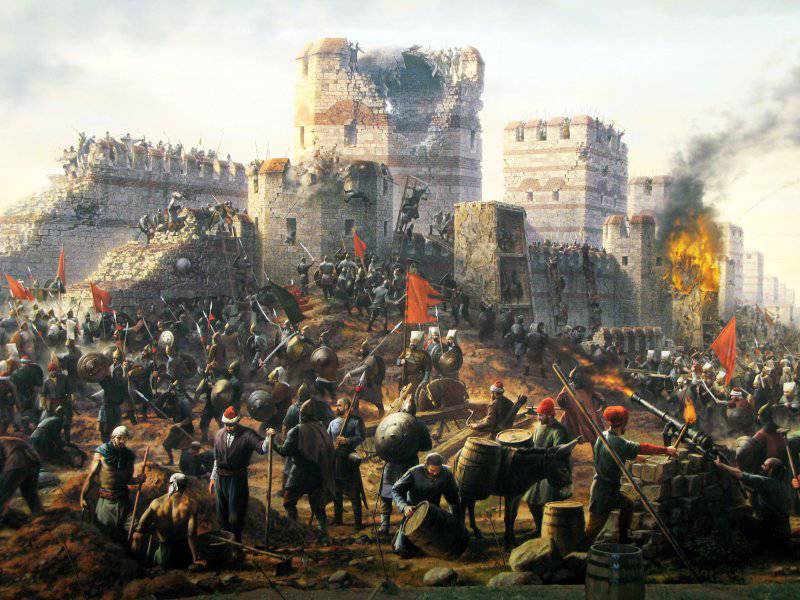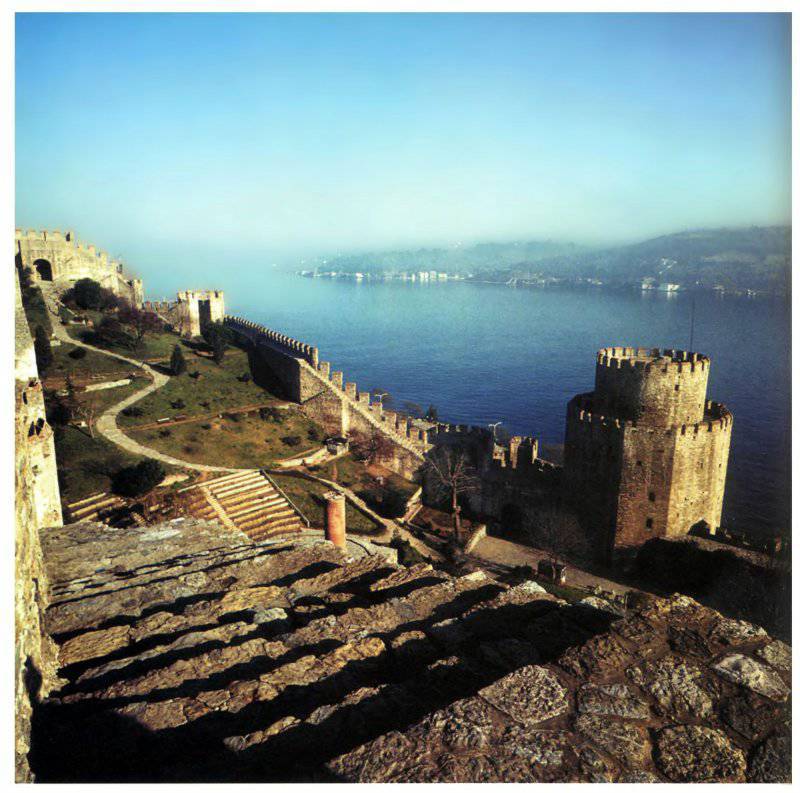Byzantine lessons. To the 560 anniversary of the fall of Constantinople. Part of 3
On the morning of April 20, three Genoese ships, which the Pope hired, approached Constantinople. They brought weapon and food. On the way to them with the same cargo joined the Byzantine ship, which before the siege of the capital did not have time to get into the Golden Horn. The entire Turkish fleet was near the city, so the Dardanelles were not guarded, they passed without problems. Having received news of the appearance of Christians, the enraged Sultan ordered Baltoglu to seize the ships or destroy them. The Turkish naval commander (he was of Bulgarian aristocrat origin, a young man taken to the Turkish service) put forward almost all of the forces, including boats and transports, on which the soldiers were put. The Ottomans were confident of victory, they had the full advantage of the number of courts and people. The inhabitants of the Byzantine capital watched the events unfolding at sea with excitement. Baltoglu offered to surrender, but the Christian ships continued to move.
From the side this fight resembled a fight between several bears - European ships were much more Turkish, with a pack of dogs. Galleys gradually made their way to the city, repelling the attacks of opponents. Higher boards protected from arrows, helped to beat off boardings, the European soldiers were better armed. This offset the higher number of enemies. Pre-prepared barrels of water helped to quickly extinguish the fire. The Byzantine ship also had a so-called. "Greek fire". The ships almost came to the city itself when the wind died down and the current began to carry the ships to the shore.
Baltoglu, seeing that the boarding tactics did not work, took the small vessels, leaving the large ones with guns. However, the low elevation angle of the ship’s cannons did not allow the crew to inflict losses and damage the spars, and a small caliber could not cause serious damage to the hulls of the Genoese ships. Baltoglu was forced to return to the tactic of rendezvous and boarding. The most fierce battle was at the Byzantine cargo ship, it was attacked by 5 with tririms led by the Ottoman admiral. Baltoglu was wounded in the eye during this fight. Ottoman wave after wave tried to break through the ship, but they were thrown away. The captains of the Genoese ships, in order to increase the possibilities for defense, skillfully maneuvering, united the ships into one floating fortress. When the sun began to set, a saving wind blew, and the Christian ships, scattering smaller enemy ships, made their way to the city. They were met by three Venetian galleys, Baltoglu was forced to retreat.
This small victory instilled hope in the Greeks. The city received some stocks of food, weapons, reinforcements in manpower, although up to half of the sailors were injured.
Breakthrough of the Ottomans Golden Horn
The Sultan was furious. This obvious and visible defeat for all weakened the morale of the army. Constantinople has repeatedly won the strait of the various armies besieging it. And here is such a slap in the face. Although with the total size of the army, casualties were insignificant. Baltoglu, for the personal courage shown in the battle and the testimonies of the officers barring him, were not executed. But they deprived of the post, poured a portion of stick punches. New commander fleet Hamza Bay was appointed.
Military advice was collected. Vizier Chandarly Khalil spoke in favor of lifting the siege, leaving the Ottoman army in exchange for an annual tribute in 70 thousand gold. Zaganos Pasha and other ministers, advisers took up the continuation of the work begun. Sultan agreed with them. Mehmed ordered to remove most of the guns from the ships and transfer them to the land for shelling from the side of the Golden Horn of the ships and enemy barriers. However, the structure of the Galatians hampered the Byzantine and Italian ships.
Then Mehmed figured out how to capture the Golden Horn. The Ottoman ruler ordered small ships to be dragged overland from the Bosphorus Strait through the Galata Hills and on to the Golden Horn. For their transportation used carts and wooden gat. From the boards chipped the flooring, covered it with fat. Specially prepared and cleared the way. Carts with cast wheels were launched and vessels brought to them. They secured them with the help of bulls, dragged ships, and carts to the shore. Each carriage was accompanied by a team that helped the bulls during descents and ascents. Gradually, until 70, ships were dragged along wooden rails past the Genoese quarter of Peru (Galata) from the Bosphorus through the hills to the northern shore of the Golden Horn Bay. The operation was performed on 22 April.
The Greeks were shocked - the enemy in the Golden Horn! The defenders of Constantinople lost their superiority in the gulf. In addition, it was necessary to increase the forces on the walls facing the bay, removing them from other directions. The Byzantine command held a series of emergency meetings. The most resolute demanded that all the available forces immediately strike the Turkish flotilla in the gulf and land the landing forces in order to burn the enemy's ships. In the end, they decided to attack. However, due to a number of delays, the preparation of the operation was delayed, and the Turks were able to gain a foothold, transfer artillery. In addition, it is likely that in Constantinople and Pere there were Ottoman agents or sympathizers of the case of Mehmed, the Turks heard about the impending attack. When, on the morning of April 28, a squad of brave men under the command of Giacomo Koko approached the Turkish squadron, he was met by strong fire from enemy artillery. Koko's ship was sunk, others were damaged and retreated. Several dozen Christian sailors were executed in front of the whole city. In response, the Greeks imposed on the walls and exponentially executed more than two hundred Muslim prisoners. Constantinople was overwhelmed by despondency, and now the danger was threatened from the Golden Horn.
Turkish ships now harassed Byzantine ships in the bay. In addition, the Ottomans put guns on rafts and began to fire the Blachernae quarter, under the protection of the flotilla. The Ottomans completed the construction of a pontoon bridge and now both parts of the army received a direct relationship. The Greeks were forced to withdraw ships, with the exception of the ships guarding the chain, to Prosforian harbor at the Golden Horn. Sailors from these ships were sent to Vlachern. However, the Turks were not able to break into the Golden Horn from the strait - the unsuccessful attacks were made on May 16-17 and 21.
May battles
Mehmed II continued the siege, although he was able to launch a general assault from two directions. He had enough troops for this operation. Sultan continued the tactics of harnessing the garrison. Ottoman artillery methodically crushed the walls, the townspeople closed the breaches every night, clearing ditches. The city began to feel food shortages among the poorest segments of the population. The emperor was forced to hold a new fundraising from churches and individuals, they bought food from merchants. Established a committee that was in charge of the distribution of products.
Skirmishes occurred in the city between the Venetians and the Genoese. Venetians blamed the Genoese for the failure of the April 28 operation. Constantine had to intervene and make them reconcile. The emperor was offered to leave the city and go in search of allies. It was believed that outside the city he could do more. However, Constantine XI Palaeologus refused, he feared that after his departure, the city’s defenders would start conflicts, which would weaken the defense of Constantinople.
And the opportunity to break out of the blockade existed. On May 3, a small vessel with 12 volunteers, dressed as Turks and under the Ottoman flag, left the city. May 23 ship returned with the report that the Dardanelles did not have a Christian fleet. Ultimately, the 9 galleys and 20 of other ships were collected around the straits, these forces were enough to withstand the 28-29 storming in May and hold out for a while if help came the day before the fall of the city. But she did not appear.
The gates of St. Romana 6 May batteries are reinforced with additional guns and punched a gap. 7 May break expanded. On the night of 7 on 8, May, the Ottomans went for an attack. After a fierce 3-hour battle, the Turkish troops rejected. The Ottomans under the command of Murad Pasha had already practically broken through, but one of the Greek soldiers cut off the leg of the Turkish pasha and reinforcements arrived under the authority of Giustiniani Longo, the emperor and Luca Notaras.
On May 8-11, Turkish artillery breached the Caligaria gate in the Vlahernosky quarter. On the night of May 12-13, the Ottomans attacked Vlaherna and were able to move into the imperial palace before reinforcements came and threw them away. Sultan again threw artillery to the gate of St.. Romana, which were the most preferred place to storm. By May 18, the tower was almost completely destroyed.
Underground war
At the same time there was an underground war. The Turks carried out the first works in the first days of the siege, but did not have great success, since there were few experienced people in this matter. When the Serbian contingent approached, the situation improved. Among the Serbs were experienced miners, they were put under the head of Zaganos Pasha.
Zaganos Pasha. It was a very interesting person. He, like many Ottoman warriors and commanders, was a new Muslim from the Greeks or Albanians. He began the service of a simple janissary. His path to success lay in faithful service to Mehmed, first as heir, and then to the sultan. Zaganos was appointed “father” - “advisor, protector and educator” Mehmed. When Mehmed returned to the throne, Zaganos was appointed second vizier, and eventually became a great vizier. He also received the post of commander of the Janissaries. In 1456, Zaganos Pasha became the scapegoat who was punished for his unsuccessful campaign against Belgrade, which then belonged to the Hungarians. The daughter of the vizier was removed from the sultan's harem, and he himself was exiled to Balikesir. In 1459, the opal was removed, and Zaganos Pasha led the rapidly developing Ottoman fleet, and then became the governor of Thessaly and Macedonia.
The first tunnel led to the Harisi Gate, but had to be thrown. Work was carried out in the river valley, the wrong place forced to throw the first dig. The next place chosen was Vlacherna at the Caligaria Gate. The Greeks spotted enemy work. First Minister Luke Notaras, he was responsible for extraordinary events, turned for help to Master Johannes Grant. On May 16, the Byzantine counter-sub-pod came out to the Turkish and the Greeks fled the enemy’s miners to flight.
The Greeks, under Grant, triumphed in an underground war. In some places the enemy was smoked with smoke, in others they used flooding. For this purpose, underground tanks were used to regulate the water in the moat. Sometimes there were underground fights. On May 23, several enemy diggers and their Turkish chief were captured. Under torture, they reported the locations and directions of all the tunnels. By 25 May they were all eliminated. Some blew up. After that, the Turks stopped trying to dig under the walls.
Sultan and Zaganos Pasha used another tool that they took from more ancient wars - siege towers. But they were used not to arrange a general assault on the walls, but as strongholds of the storming detachments and closed the soldiers from enemy fire. In order not to be burned, they were covered with ox and camel skins, watered regularly. One huge tower nevertheless decided to use for the assault. They prepared the ladders for transferring to the walls, filled up and strengthened the moat so that you could push the tower close to the walls of the city. On the night of 18 on 19 in May, the Greeks, with an unexpected sally, destroyed this tower with the help of kegs of gunpowder. After some of the other towers were destroyed by some means or other, the Ottomans dismantled the remaining towers, they no longer corresponded to the era.
These were the last victories of the Byzantine army. The situation has consistently deteriorated. It was increasingly difficult for the Greeks to fill the gaps in the valley of Lykos, the Ottomans approached the walls themselves and filled up the moats. The defenders of the city tried to erect ramparts of earth, stones, logs, and build palisades at the site of the destroyed walls. Conducting counterattacks was becoming more difficult, the losses and fatigue of the troops increased. The Ottomans easily changed the troops to more recent ones. There were relatively few killed, but the number of wounded was constantly growing. Hunger was coming. The garrison had to exert all forces to repel enemy attacks and at the same time close up new and new breaches.
Morale is constantly falling. There were frictions between the Italians and the Greeks, the Venetians and the Genoese. Morale especially fell when the ship returned with the news that there would be no help. People everywhere saw ominous signs. Odigitria (Vlacherna icon), written by the Evangelist Luke and considered to be the guardian of Constantinople, fell from a stretcher during a solemn procession, when the monks made a round of the city. Then the city was shrouded in fog, and an unusual glow was noted around Sofia, which caused confusion in both camps. The Muslim command was not lost, and interpreted this sign as the light of true faith, which will shine in this temple. 24 May a lunar eclipse occurred, which was also perceived as a bad sign.
It must be said that not all was well in the Ottoman camp. Half of the regular troops were cavalry, unaccustomed to such battles. Grew tiredness and discontent. A huge army and fot could not do anything with a small Greek-Italian garrison. Almost all ideas - underground tunnels, siege towers, ended in failure. The garrison reflected all the attacks, during which the Turks suffered heavy losses. It was not possible to break through the walls. There were concerns that Christian countries would help Constantinople. There were rumors about the approach of a huge Christian fleet and the transition of the army of the Hungarian king across the Danube. Hungary broke the truce with the Ottoman Empire. In addition, in the Ottoman elite, among the old advisers of the father, there was an opposition headed by a grand vizier. Chandarly Khalil still advocated a compromise with the Byzantine emperor and insisted on the threat from the western countries.
The Ottoman Sultan Mehmed II sent the last embassy to the Byzantine capital, which was headed by the ruler Kastomonu and Sinop Isfendiyar oglu Ismail Bey. He had friendly relations among the Byzantine elite. He transferred the conditions of the Ottoman ruler: Constantine XI Palaeologus had to leave the city to the Turks, retire to Morea (Southern Greece), residents were promised to save life and property or pay a huge ransom for the city - 100 thousand gold. Constantine refused, perhaps hoping for the arrival of the Venetian fleet or the war of the Ottomans with the Hungarians. He replied: “God will not allow me to live as an emperor without an empire. If the city falls, I will fall with it. Whoever wants to seek salvation, let him seek him as best he can, and who is ready to meet death, let him follow me. ”
25 May Sultan gathered a military council. The Grand Vizier proposed to lift the siege. From the very beginning, he was against the assault on Constantinople and now believed that the very course of the siege confirmed his correctness. He recalled the failures of the Ottoman army. According to him, the threat from the West was strong - at any moment the fleet of Venice and Genoa could approach. He offered to immediately make peace on favorable terms and withdraw the troops. His opponent was Zaganos Pasha. He argued that this time their western enemies would not unite efforts, that the fears of the Grand Vizier were in vain. The Christian powers are divided, and the Venetian fleet, if it comes, cannot do anything. Therefore, it is necessary not to leave, but to increase pressure, the fortress will soon fall. He also remembered the experience of the great Alexander of Macedon, who had won half the world as a young man. Alexander and Achilles were Mehmed's favorite heroes. Many young generals supported Zaganosa Pasha. Sultan ordered the preparation of a general assault.
To be continued ...
- Alexander Samsonov
- Byzantine lessons. To the 560 anniversary of the fall of Constantinople
Byzantine lessons. To the 560 anniversary of the fall of Constantinople. Part of 2
Byzantine lessons. To the 560 anniversary of the fall of Constantinople. Part of 3
Byzantine lessons. To the 560 anniversary of the fall of Constantinople. Part of 4




Information